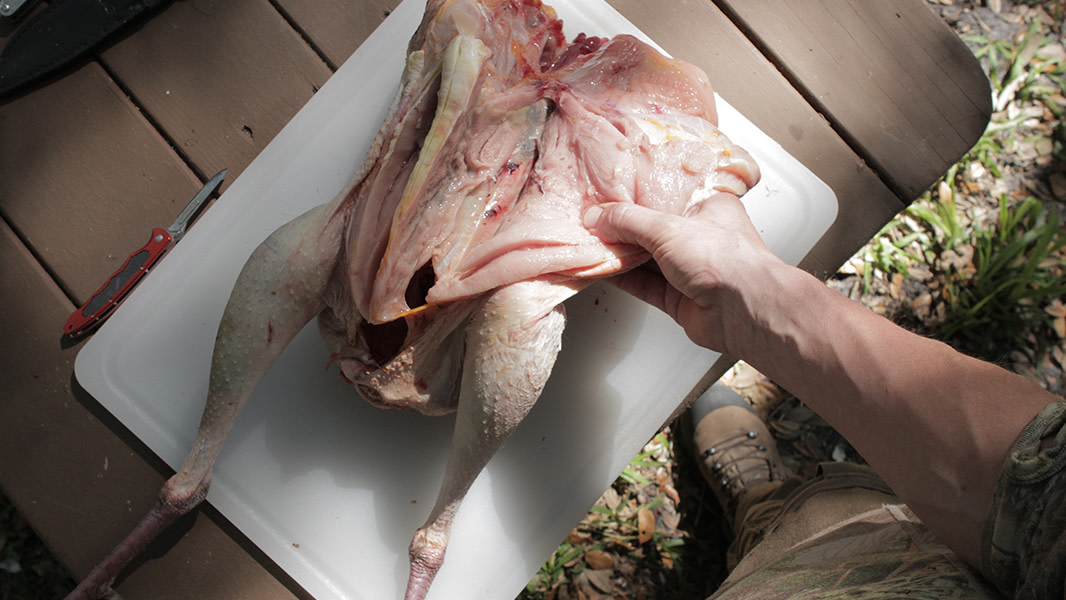
The Role of Bone Broth in Food and Water Storage for Prepping
This guide will delve into the benefits of bone broth, how to source and store it, and its integration into a comprehensive food and water storage plan.
Aug 19, 2024 | by N Johansson

Butchering and preserving your own turkey at home is a valuable skill that not only saves money but also ensures that the meat you serve your family is fresh and free from unnecessary additives. Whether you’re preparing for a self-sufficient lifestyle or just want to take control of your food sources, learning how to butcher and preserve a turkey is an essential skill. In this guide, we'll walk you through the entire process, from preparing your workspace to safely storing the meat for long-term use, with step-by-step instructions.
Before you begin, make sure you have the following tools on hand:
A well-organized workspace makes the butchering process smoother and safer. Start by cleaning your area thoroughly with a bleach cleaner to kill any bacteria. Lay out your tools within easy reach, and have a waste bin or bag ready for discarded parts. If possible, work in a cool area to keep the meat fresh and reduce the risk of bacterial growth.

Begin by placing the turkey breast-side up on your cutting board. Reach into the body cavity and pull out the neck and giblets. These can be set aside for making stock or gravy. Be sure to check both cavities (front and back) to ensure all parts are removed.
Next, lay the turkey on its back and stretch out one wing. Use your knife to slice through the skin where the wing meets the body. Feel for the joint with your knife and cut through it cleanly. Gravity can help you here—let the wing hang off the edge of the cutting board as you work. Repeat the process on the other wing.
With the turkey still on its back, grasp one leg and pull it away from the body. Slice through the skin between the leg and the breast, exposing the joint. Cut through the joint where the thigh bone meets the backbone, using your knife to separate the leg and thigh in one piece. Repeat on the other side.
For the breast, you have a couple of options:
Turkeys can be heavy and unwieldy. If you’re working with a particularly large bird, consider using a bigger kill cone to manage its size more easily. Alternatively, ask a partner to assist with holding the bird steady while you make cuts.
To ensure the meat remains tender and juicy, avoid cutting too far ahead of cooking time. If you’re not cooking immediately, break down the bird into smaller parts and refrigerate or freeze them promptly. Smaller cuts cook more evenly and are less likely to dry out.
Once your turkey is butchered, preserving the meat through pressure canning is an excellent way to ensure you have ready-to-use turkey for months to come. Here's how to do it:
Canned turkey is incredibly versatile. You can use it in soups, stews, casseroles, or as a quick protein addition to salads or sandwiches. Just open a jar, drain the liquid if needed, and add the meat to your recipe.
Safety Note: Always ensure that your pressure canner is functioning correctly and follow the manufacturer's guidelines. Proper pressure canning is essential to prevent the risk of foodborne illness.
Maintaining hygiene is critical during the butchering and canning process. Always wash your hands thoroughly before and after handling raw meat, and use disposable gloves if possible. Clean your cutting board and tools with hot, soapy water followed by a bleach solution to prevent cross-contamination. Store the turkey meat in airtight containers or vacuum-sealed bags in the refrigerator or freezer to keep it fresh until ready to can.
Butchering and preserving a turkey at home is a rewarding skill that enhances your self-sufficiency and culinary capabilities. Not only does it allow you to save money, but it also gives you the freedom to customize your cuts for a variety of recipes and ensures that you have nutritious, ready-to-use turkey meat on hand for months to come. With this guide, you're well on your way to mastering the art of turkey butchering and preservation, leading to fresher, more flavorful meals and a more sustainable lifestyle.